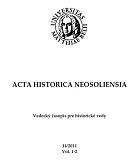Dva keramické súbory zo Starých Hôr (okres Banská Bystrica)
The two groups of medieval pottery from Staré Hory
Author(s): Martin KvietokSubject(s): Archaeology
Published by: Filozofická fakulta Univerzity Mateja Bela
Keywords: Staré Hory; medieval pottery; Haliar; Richtárová; mining
Summary/Abstract: The primary aim of the present article was processing of two groups of medieval pottery that were found in the area of Staré Hory. This area, rich of copper ores, contains evidence of the presence of man in prehistoric times. The attention of archaeologists is focused almost exclusively on the most famous site in this region Špania Dolina – Piesky (Sandberg). At the beginning of year 2012, author of this article received two collections of medieval pottery and informations of location of finds. First collection comes from Staré Hory-Haliar and second from location Staré Hory – Richtárová. After overall view of both collections from Haliar and Richtárová we can conclude that these collections of late medieval pottery are very similar. However, it seems that collection from Haliar is a little older. It shows the presence of archaic shapes of rims as well as a much smaller percentage of glazed pottery. Based on the analogies, we can set collection from Haliar to the turn of the 14th and 15th century, respectively first half of the 15th century. Collection from Richtárová is a little younger. This collection is also dated by the silver coin to the end of the 14th century or to the beginning of the 16th century. Because of the great similarity of our published material mainly with ceramics obtained in the central Slovakian mining towns, mostly with material from Banská Bystrica, we assume that both collections are the result of trade links between mining communities and the medieval town. This formed the economic base of mining activities in the area from second half of the 13th century. The city supplied the mining communities especially with food and crafts, among which the products of urban pottery workshops are included. The remarkable similarity with pottery found in Partizanske-Šimonovany, and especially in Branč-Veľká Ves, may indicate contacts of the area of mining towns with vineyards in the middle Nitra region. It is known that the former mine owners in Banská Bystrica after the redemption of their mines to J. Thurzo, refocused themselves on trade of handicraft and food. But the most lucrative business article was the wine. Between the years 1459 – 1526 from 22 to 31 Banská Bystrica citizens dealt with wine trade. Very interesting are also the places where these collections were found. Although the terraces, from which findings came, are made up of drawn-out rock, they have the characteristics of artificial modifications, probably for the construction of overhead objects for a long term use. Finds as a stove parts or fragment of lock could serve as an evidence for the existence of such objects At present we can only assume that it could have been the homes of families of miners established near the mine (Richtárová case) respectively the place for the technical support of mining activities such as warehouses or areas where miners gathered before and after work (Haliar case).
Journal: Acta historica Neosoliensia
- Issue Year: 14/2011
- Issue No: 1
- Page Range: 149-172
- Page Count: 24
- Language: Slovak

